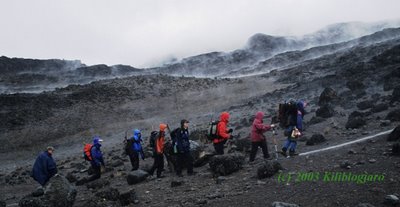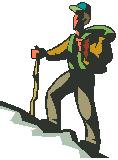 Am I in good enough shape to climb Kilimanjaro?
Am I in good enough shape to climb Kilimanjaro?People curious about climbing Kilimanjaro ask me a lot of questions about the trip: how high is the mountain? Is travel in East Africa safe? What about malaria? Is there a lot of snow? How much does it cost?
Photo: Climbers approach the Lava Tower camp after a rainstorm
These are all great questions, many of which I’ll answer in this blog. But one of the most important questions is not asked often, or early, enough: What kind of fitness do I need to be in to climb the mountain?
Once you’ve made the commitment to climb the mountain, it’s easy to imagine the epic experience you’ll have traveling through the various vegetation zones of the mountain, the views from high on the peak, and the bragging rights you’ll earn. Indeed, you see yourself having a cocktail back in the US,
“Well, darling, I just returned from a perfectly delightful climb of Mount Kilimanjaro. What have YOU been up to?”Ah, the sweet taste of success.
Hold on a second. We’re presupposing that you can make it to the top, and while there are not reliable statistics kept on the percentage of climbers who summit, MANY do not. While many events can conspire to keep you from reaching the summit, it would be a shame to travel all the way to Tanzania and not be physically ready for the climb.
In this entry, we’ll concentrate on the physical demands of the climb and how to train for them. Please note: consult a physician before training for a climb or undertaking any exercise program.
Major Effort
To climb Kilimanjaro, you’ll be hiking between 1,000 and 2,000 vertical feet per day with a pack of about 15 to 20 pounds. Porters carry the rest of your equipment, so this doesn’t seem like a lot.
Keep in mind, though, that the last day is a real burner. Any of the common trekking routes on Kilimanjaro involve over 3,000 vertical feet of elevation gain to the 19,341-foot summit—a major effort to say the least.
Your success on this last day will depend in part on how well you’ve acclimatized. You won’t acclimatize very well if each of the previous days represented an all-out effort. This means you need to be in good shape!
 Find a hill
Find a hillThe key to excellence in any sport is specificity. That means to do well on Kilimanjaro, you need to train by going uphill. Find a trail and put a15-20 pound pack on your back and start hiking!
Ideally your hike will be convenient enough that you can find time for it once or twice per week.
When you’re hiking, take it nice and easy. Kilimanjaro is more a marathon than a sprint and you’ll want to start slow to avoid injury or burning out in your training.
Work yourself up to 1,000 to 2,000 vertical feet in your hike. It’s tough for some people to estimate vertical change (and most people overestimate), so check the Internet or a hiking guide for an accurate estimate of your trail.
Start a habit
It’s equally important to start training early and then to keep at it. Establish a regular schedule and stick to it, rain or shine.
Set realistic goals. You should make a training schedule that fits into your already busy life. If your schedule gets really hectic, don’t just throw your training out the window-instead, do what training you can.
Get creative
What if you don’t have a hill? Don’t despair. You can work out in a gym, on a bike, run, or swim,
 and still accomplish a lot. Work with a trainer with the goal of long slow distance training (LSD)—your goal is to prepare your heart and lungs for a very long hike, not for a sprint, so sprinting in training won’t help much.
and still accomplish a lot. Work with a trainer with the goal of long slow distance training (LSD)—your goal is to prepare your heart and lungs for a very long hike, not for a sprint, so sprinting in training won’t help much.You should still look for opportunities to strengthen the specific sets of muscles used in climbing. Long flights of stairs or “step mills” and “stair climbers” in the gym are also reasonable substitutes.
Questions? Email Kiliblogjaro@gmail.com
No comments:
Post a Comment